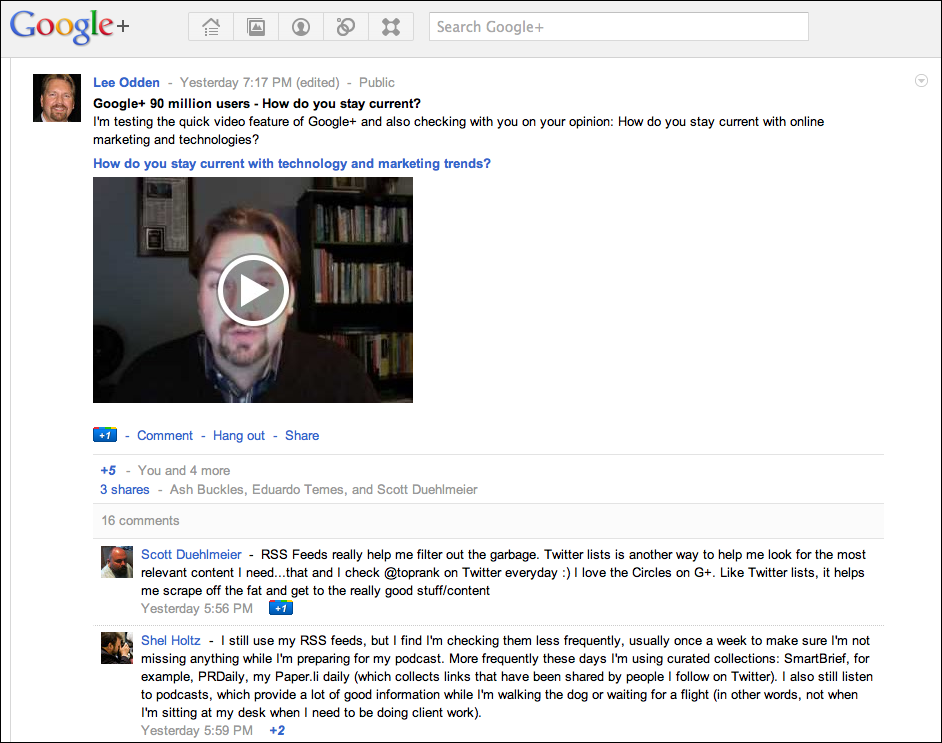 Online Marketing is all about information. And people. Making connections that solve marketing problems in today’s environment of social and technological innovation can be challenging. Like many readers of this blog, a big part of what I do as an Internet Marketer centers around being able to consume large amounts of information or better, the right information, synthesizing it and using insights to help others make sense of the challenges and opportunities they face with marketing on the web.
Online Marketing is all about information. And people. Making connections that solve marketing problems in today’s environment of social and technological innovation can be challenging. Like many readers of this blog, a big part of what I do as an Internet Marketer centers around being able to consume large amounts of information or better, the right information, synthesizing it and using insights to help others make sense of the challenges and opportunities they face with marketing on the web.
As an author, frequent speaker at industry conferences, advisor to clients and the people who serve our clients, there’s a sense of urgency for me to stay current and to understand what current events in the digital marketing world mean in the context of individual situations. It’s not enough to observe that news events and trends are happening, but to understand what those observations mean as it relates to impact on business, on customers and how to continue the pursuit of successful online marketing.
Simply finding and sharing news ala basic “curation” is a cheap commodity. Value comes from identifying bigger picture patterns and synthesizing that information into practical business advice. I like what Christian Adams said in a G+ thread, “When you have information overload across multiple channels you start to pick up on common threads and trending topics”. This is the essence of curation that creates value and there’s no substitute for human filtering.
In Avinash Kaushik’s recent post, “The 2015 Digital Marketing Rule Book. Change or Perish” one of his 7 Rules for Digital Marketing Revolutionaries concerns the need for marketing practitioners (which is applicable to professionals in any industry) to extend their expertise beyond core skills. “You can no longer be good at just one thing, or two. It is a 10-thing world now (and maybe a 20-thing world soon).”
As a professional, it’s essential for you to filter signal from a mass of noise to grow expertise in your core discipline as well as others. The question is, where do you get the information to stay current? How do you filter out the noise?
After writing most of this post I tried the new quick video post feature on my Google+ account to ping the smart connections I have there for their ideas on how to stay current. While some people still use RSS via Google Reader, usage of the traditional RSS feed has been displaced by Twitter lists, Google+ circles and more so what Shel Holtz called “curated collections” like what you can find at SmartBrief and PR Daily newsletters. Other curated news services mentioned include paper.li, Percolate, news.me, Pulse, FlipBoard and the recently acquired Summify. Trunk.ly is another useful service that works with Twitter but is being shut down.
Below is a screenshot and here’s a link to see everyone’s full comments. Thanks to Shel Holtz, Scott Duehlmeier, Christopher Drinkut, Ash Buckles, Christian Adams and Corey McNeil for chiming in.

While I’ve been able to gain a lot of knowledge and insight over the past 14 years of being in this business, I know that I’m only getting a fraction of what I’d like to know. Every day is a learning experience. Every day is massive piece of humble pie working with a great team at our agency. Transparency, competition and information availability means earning your stripes every day. I think that perspective works pretty well as evidenced by the growth and quality of our team and client roster.
There are many people who have asked me how I stay current and on top of what’s important in the online marketing and PR world. Some of what I do is scheduled and methodical. Some is more intuitive and opportunistic. Both types of activities are guided by a pursuit of wisdom and an interest in being able to provide high value insight to others that will help our business grow. I have a feeling some of our readers are in the same boat: wanting to find ways to stay informed and several steps ahead.
Here are a few of the things that I do to stay current and on top of not only what’s happening in the Search, Social Media, PR and Content Marketing world, but what it means for developing relationships, solving problems and growing the business.
1. Read social feeds & email. I typically do this between 4:30 and 6am. I’ll bookmark articles & media for later use and reading, taking notes on each item. I’ll also queue up Tweets and other social sharing with social networks. Many of the tips, tactics and news I share publicly are the things I share internally, except with added insight. Evernote ROCKS for managing this.
2. Meet with my right hand marketer. You may have noticed Ashley posting here frequently. She’s our Marketing Manager here at TopRank Online Marketing and we regularly discuss all sorts of content, social media, email, event, website, blog and book related topics – every day.
3. Meet with our group of Account Managers on tactical case studies, observations/insights into successes with client Content, Social, Email, PPC, SEO programs. We also discuss situations that need resolving. It’s great to see the AMs working together to identify solutions. Our AMs are project managers and consultants that directly interact with both clients and internal subject matter experts. They are on the front-lines of what it means to develop online marketing strategy, make recommendations, oversee implementation, measure results and work to identify new opportunities. Their insights into daily marketing problems and solutions is priceless.
4. Review our own Analytics & Reports: I’ve been watching key metrics related to our blog and website for a very long time. Traffic, links, search data, time on site, inquiries and other goal page activity paint an interesting picture when overlaid with external KPIs like social shares, comments, links and media mentions.
5. Marketing TopRank – On a regular basis I work with our marketing manager, Ashley Zeckman on developing our online marketing approach and having things tested out to see what we might scale or adjust for better performance with our own agency’s marketing. Being able to test online marketing, SEO and Social Media Marketing tactics out on our own sites has been incredibly valuable over the years when it comes to creating first-hand knowledge that can be shared with staff and clients.
6. Talk with Customers – Every time I get to talk to one of our clients, I learn invaluable lessons about how they see search, social and content marketing contributing to the success of their business.
7. Research & Write – Between blogging over 2,500 times and writing numerous contributed articles, I have found that developing writing skills has been one of the most profitable things I’ve ever done. I’ve been writing a book (Optimize) over the past few months, which has taken considerable time in addition to daily work. The process of writing a book is not for the faint of heart, but it has made me smarter and more strategic in how I view modern online marketing strategy.
8. Research & Presentations – Another profitable investment (in terms of knowledge and for our business) has been speaking at events. The research and preparation for presentations requires an understanding of the subject matter that extends far beyond day to day familiarity. Packaging content to be relevant to specific audiences as well as educational and entertaining means thinking that content through. The process helps create mental models for explaining key concepts and can serve as a basis for many other forms of content creation.
9. Research and Training – One of the big initiatives I have this year is to develop internal training beyond the things we’ve established so far. Identifying external sources of training such as industry conferences and workshops for our team to attend as well as building our own workshops for internal use and for our clients is another situation that calls for thoughtful consideration, planning and packaging. Related to presentations, I’m also involved with providing SEO or Social SEO to other agencies (especially PR agencies) and marketing communications departments within companies. Collecting case studies, examples and keeping tactics current keeps me on my mental toes.
10. Connect with Industry Peers – In the time I’ve been publicly active in the internet marketing and PR world, I’ve been able to make some incredible connections with amazingly smart people. Outside of working with our internal team of consultants, there is no substitute when it comes to gaining high value information than connecting with other professionals that are as passionate and fanatical about marketing and online business as you are.
11. Revisit Social Streams – This is a later in the evening activity but it’s a good way to end the work part of the day and get ideas for the next. Using Google Reader, Hootsuite, Disqus and other tools, identify any new articles worth reading, cluster them together according to theme and take notes. I’ll take time to focus on mainstream media publications, not just industry blogs and news websites.
Another approach to staying current is to form a mastermind group. I first head of this from reading Napoleon Hill many years ago and it’s even more powerful now. Find likeminded professionals and agree to connect on collective and individual areas of focus. A mastermind is not only about sharing information but working with each other to achieve goals.
I don’t do all these things every day of course, but it represents a number of the things that have been instrumental in keeping me close to tactics as well as in line with more strategic perspectives on new events and industry changes. Would reading my email and social feeds for 10 min a day be a better alternative to free up time for other business tasks? Maybe, but then I wouldn’t be able to output as much as I do or bring as much value that results in better service to customers, a healthier social network and a growing business.
If staying current and informed is essential for your job, how do you keep up to date? How do you make each day a positive learning experience?


